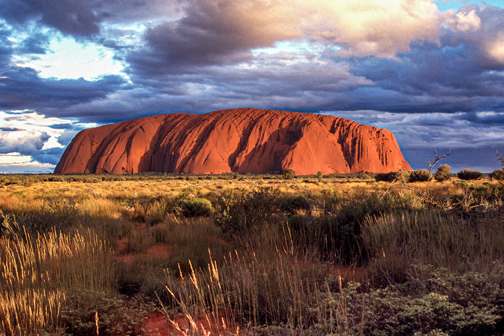
Why the saddles have to fit like tailor-made shoes

Day: 35
Sunrise:
07:04
Sunset:
17:15
As the crow flies:
22,6
Daily kilometers:
26
Cleary Heart Camp – 15.06.2000
After the terrible night, the weather clears up a little. We need an hour longer than in the last few days to pack up the wet camp. Nevertheless, we manage to be back on the road by 11 am. The loamy path next to the railroad line is too slippery for the camel’s feet. Again and again, their clumsy feet slip, so we decide to walk along the nearby road with hardly any traffic. Jo and Tanja walk behind the caravan again to warn me of approaching vehicles. We make good progress and the animals seem to like the rough asphalt. “Car! Car!” I hear Tanja’s warning call.
It’s 2 p.m. when Tom and his friend Petro meet us. I stop the caravan to greet them. As always, it’s a lovely reunion and you could be forgiven for thinking that weeks have passed since we last saw each other. Tom walks alongside the camels to check with his expert eye what is wrong with the saddle construction. “No question, the bags are hanging too low!” he says after just a few minutes. We decide to discuss this in more detail the next day at camp. So far we are only an hour and a half’s drive away from Goomalling and if we have to change the saddles again, this is our last chance. I would like to take this opportunity to explain why it is so important to have perfectly fitting saddles for our camels.
If the heavy load is not one hundred percent evenly distributed on the camel’s back, they get pressure points. Pressure marks, however small they may be, have the potential to develop into a serious problem over time. The animals can then develop open wounds within just a few days. Flies then settle on the wound to lay their eggs. Maggots hatch from these and eat their way into the meat of the animals. This means that the injury hardly has a chance to heal. The camels also get all kinds of tensions, comparable to humans. These can develop into severe back or joint problems. Of course there are many other examples, but hopefully these explain why we are so keen to design the right equipment for the animals. It is also important for me to mention once again that we still have at least 6800 kilometers of outback ahead of us. Should only one of the camels fall ill due to initial negligence and then perhaps die, our own lives are at risk despite the possibility of connecting to the outside world. The saddles that Verne has built have already been revised several times and still don’t fit. Unfortunately, we lost a lot of important time due to this problem, but on the other hand we learned a lot.
A SPECIAL SURPRISE
Tom and Petro drive ahead and find a beautiful campsite for us. All criteria are met. The site cannot be seen from the road, there is enough food for the camels, enough firewood and trees to align and hang up the antenna of the radio radio to the south and on the other side we are happy about the open view to the northeast to align our satellite phone.
At 5.15 p.m. we also reach our weekly destination of Cleary. We are satisfied because we have covered 111 kilometers in the last 5 days. If we keep up this pace we will reach Broome in time. Unfortunately, so much has come between our plans in the last few weeks and months that we can only hope that everything continues to go well. In the evening, there is an exuberant atmosphere around the campfire. Tom and Petro have brought lamb chops and Italian sausages, which are currently sizzling on the grill. We also drink a few beers that taste really delicious. Tom then unwraps a very special surprise. He hands me an A4-sized package. I quickly and excitedly unpack it and can’t believe my eyes. It is our book about the preparation for the Red Earth Expedition. I hold it in my hands, beaming with happiness. “7000 km on foot through Australia’s outback” is the title. It has once again been published by Burgschmiet Verlag. So far Tanja and I have only seen a copy of it and now, 6 weeks after it was published, I am being presented with it by a friend here by the lambing campfire. In the glow of the full moon, the Milky Way and fire, it makes the rounds. It was not easy to put some of our experiences into book form during the expedition. I would never have thought it possible that something like this was feasible at the time of the expedition, but the treasure in my hands proves us wrong.
When everyone has gone to bed, I have a little chat with Petro. He has given up his base in Perth and will be touring Australia for the next few years with his faithful dog and a specially prepared Landcruiser. “I will always earn money. As a plumber, I’ll never run out of work here in Australia. I’ll probably develop my talent as a songwriter even more and perform with my guitar in all sorts of different places,” he says in his pleasant deep voice. The flickering flames illuminate his cheerful face and it makes me happy to have met this extremely likeable man.

